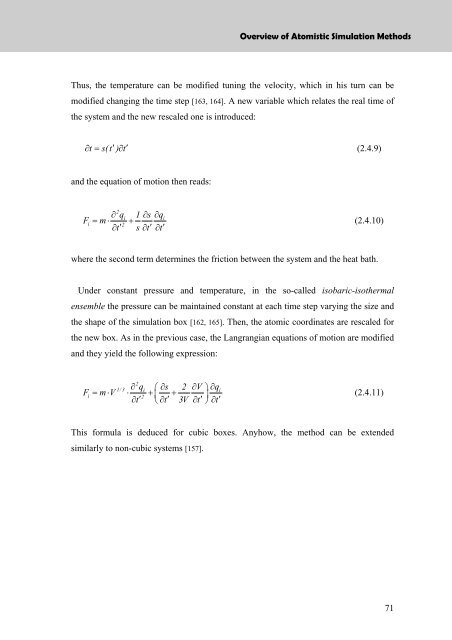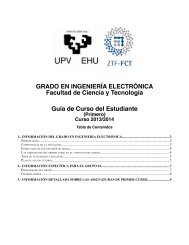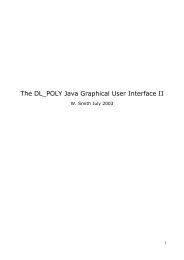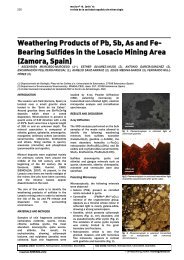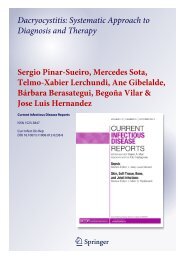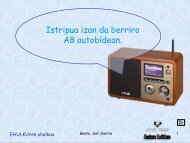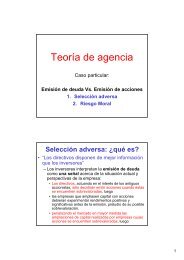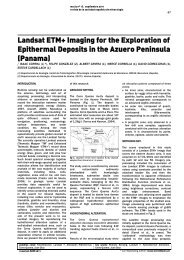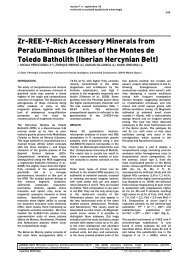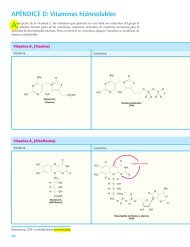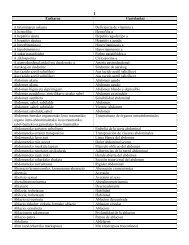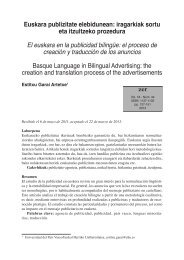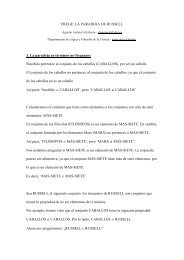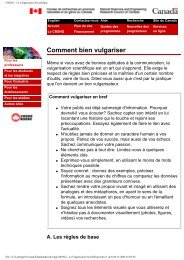- Page 1 and 2:
Atomistic Simulation studies of the
- Page 3:
AUTORIZACION DEL/LA DIRECTOR/A DE T
- Page 7:
ACTA DE GRADO DE DOCTOR ACTA DE DEF
- Page 11 and 12:
Acknowledgements Probably, the ackn
- Page 13:
esearcher in his group, and the nic
- Page 16 and 17:
Atomistic Simulation studies of the
- Page 18 and 19:
Atomistic Simulation studies of the
- Page 20 and 21:
Atomistic Simulation studies of the
- Page 22 and 23:
Atomistic Simulation studies of the
- Page 24 and 25:
Atomistic Simulation studies of the
- Page 26 and 27:
Atomistic Simulation studies of the
- Page 28 and 29:
Atomistic Simulation studies of the
- Page 30 and 31:
Atomistic Simulation studies of the
- Page 32 and 33:
Atomistic Simulation studies of the
- Page 34 and 35: Atomistic Simulation studies of the
- Page 36 and 37: Atomistic Simulation studies of the
- Page 38 and 39: Atomistic Simulation studies of the
- Page 40 and 41: Atomistic Simulation studies of the
- Page 42 and 43: Atomistic Simulation studies of the
- Page 44 and 45: Atomistic Simulation studies of the
- Page 46 and 47: Atomistic Simulation studies of the
- Page 48 and 49: Atomistic Simulation studies of the
- Page 50 and 51: Atomistic Simulation studies of the
- Page 52 and 53: Atomistic Simulation studies of the
- Page 54 and 55: Atomistic Simulation studies of the
- Page 56 and 57: Atomistic Simulation studies of the
- Page 58 and 59: Atomistic Simulation studies of the
- Page 60 and 61: Atomistic Simulation studies of the
- Page 62 and 63: Atomistic Simulation studies of the
- Page 64 and 65: Atomistic Simulation studies of the
- Page 66 and 67: Atomistic Simulation studies of the
- Page 68 and 69: Atomistic Simulation studies of the
- Page 70 and 71: Atomistic Simulation studies of the
- Page 72 and 73: Atomistic Simulation studies of the
- Page 74 and 75: Atomistic Simulation studies of the
- Page 76 and 77: Atomistic Simulation studies of the
- Page 78 and 79: Atomistic Simulation studies of the
- Page 80 and 81: Atomistic Simulation studies of the
- Page 82 and 83: Atomistic Simulation studies of the
- Page 86 and 87: Atomistic Simulation studies of the
- Page 88 and 89: Atomistic Simulation studies of the
- Page 90 and 91: Atomistic Simulation studies of the
- Page 92 and 93: Atomistic Simulation studies of the
- Page 94 and 95: Atomistic Simulation studies of the
- Page 96 and 97: Atomistic Simulation studies of the
- Page 98 and 99: Atomistic Simulation studies of the
- Page 100 and 101: Atomistic Simulation studies of the
- Page 102 and 103: Atomistic Simulation studies of the
- Page 104 and 105: Atomistic Simulation studies of the
- Page 106 and 107: Atomistic Simulation studies of the
- Page 108 and 109: Atomistic Simulation studies of the
- Page 110 and 111: Atomistic Simulation studies of the
- Page 112 and 113: Atomistic Simulation studies of the
- Page 114 and 115: Atomistic Simulation studies of the
- Page 116 and 117: Atomistic Simulation studies of the
- Page 118 and 119: Atomistic Simulation studies of the
- Page 120 and 121: Atomistic Simulation studies of the
- Page 122 and 123: Atomistic Simulation studies of the
- Page 124 and 125: Atomistic Simulation studies of the
- Page 126 and 127: Atomistic Simulation studies of the
- Page 128 and 129: Atomistic Simulation studies of the
- Page 130 and 131: Atomistic Simulation studies of the
- Page 132 and 133: Atomistic Simulation studies of the
- Page 134 and 135:
Atomistic Simulation studies of the
- Page 136 and 137:
Atomistic Simulation studies of the
- Page 138 and 139:
Atomistic Simulation studies of the
- Page 140 and 141:
Atomistic Simulation studies of the
- Page 142 and 143:
Atomistic Simulation studies of the
- Page 144 and 145:
Atomistic Simulation studies of the
- Page 146 and 147:
Atomistic Simulation studies of the
- Page 148 and 149:
Atomistic Simulation studies of the
- Page 150 and 151:
Atomistic Simulation studies of the
- Page 152 and 153:
Atomistic Simulation studies of the
- Page 154 and 155:
Atomistic Simulation studies of the
- Page 156 and 157:
Atomistic Simulation studies of the
- Page 158 and 159:
Atomistic Simulation studies of the
- Page 160 and 161:
Atomistic Simulation studies of the
- Page 162 and 163:
Atomistic Simulation studies of the
- Page 164 and 165:
Atomistic Simulation studies of the
- Page 166 and 167:
Atomistic Simulation studies of the
- Page 168 and 169:
Atomistic Simulation studies of the
- Page 170 and 171:
Atomistic Simulation studies of the
- Page 172 and 173:
Atomistic Simulation studies of the
- Page 174 and 175:
Atomistic Simulation studies of the
- Page 176 and 177:
Atomistic Simulation studies of the
- Page 178 and 179:
Atomistic Simulation studies of the
- Page 180 and 181:
Atomistic Simulation studies of the
- Page 182 and 183:
Atomistic Simulation studies of the
- Page 184 and 185:
Atomistic Simulation studies of the
- Page 186 and 187:
Atomistic Simulation studies of the
- Page 188 and 189:
Atomistic Simulation studies of the
- Page 190 and 191:
Atomistic Simulation studies of the
- Page 192 and 193:
Atomistic Simulation studies of the
- Page 194 and 195:
Atomistic Simulation studies of the
- Page 196 and 197:
Atomistic Simulation studies of the
- Page 198 and 199:
Atomistic Simulation studies of the
- Page 200 and 201:
Atomistic Simulation studies of the
- Page 202 and 203:
Atomistic Simulation studies of the
- Page 204 and 205:
Atomistic Simulation studies of the
- Page 206 and 207:
Atomistic Simulation studies of the
- Page 208 and 209:
Atomistic Simulation studies of the
- Page 210 and 211:
Atomistic Simulation studies of the
- Page 212 and 213:
Atomistic Simulation studies of the
- Page 214 and 215:
Atomistic Simulation studies of the
- Page 216 and 217:
Atomistic Simulation studies of the
- Page 218 and 219:
Atomistic Simulation studies of the
- Page 220 and 221:
Atomistic Simulation studies of the
- Page 222 and 223:
Atomistic Simulation studies of the
- Page 224 and 225:
Atomistic Simulation studies of the
- Page 226 and 227:
Atomistic Simulation studies of the
- Page 228 and 229:
Atomistic Simulation studies of the
- Page 230 and 231:
Atomistic Simulation studies of the
- Page 232 and 233:
Atomistic Simulation studies of the
- Page 234 and 235:
Atomistic Simulation studies of the
- Page 236 and 237:
Atomistic Simulation studies of the
- Page 238 and 239:
Atomistic Simulation studies of the
- Page 240 and 241:
Atomistic Simulation studies of the
- Page 242 and 243:
Atomistic Simulation studies of the
- Page 244:
Atomistic Simulation studies of the


